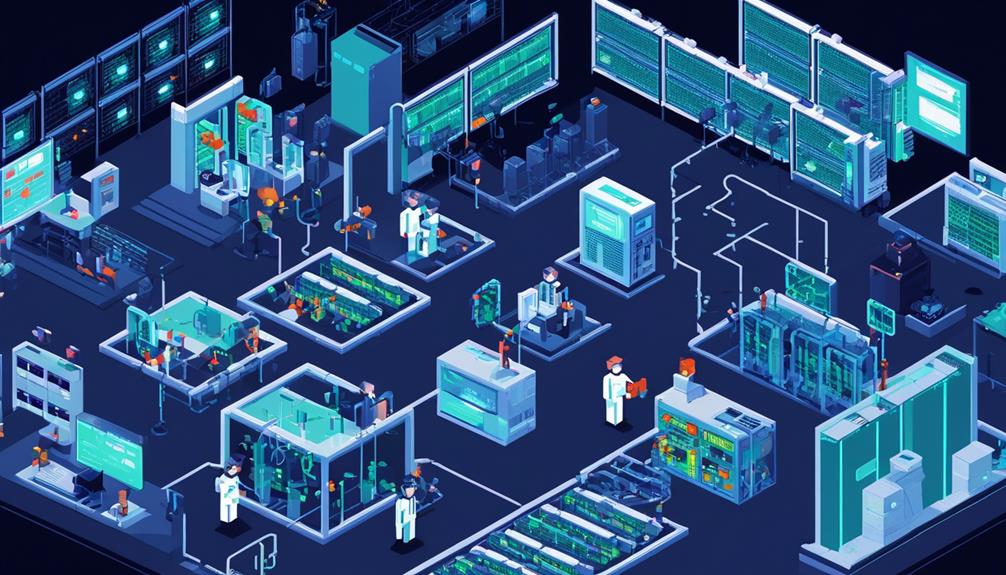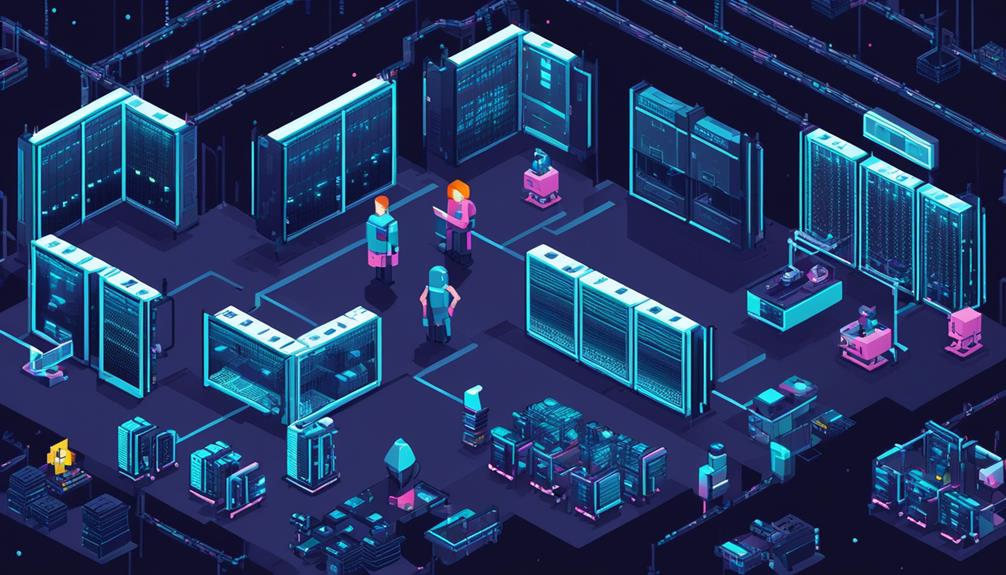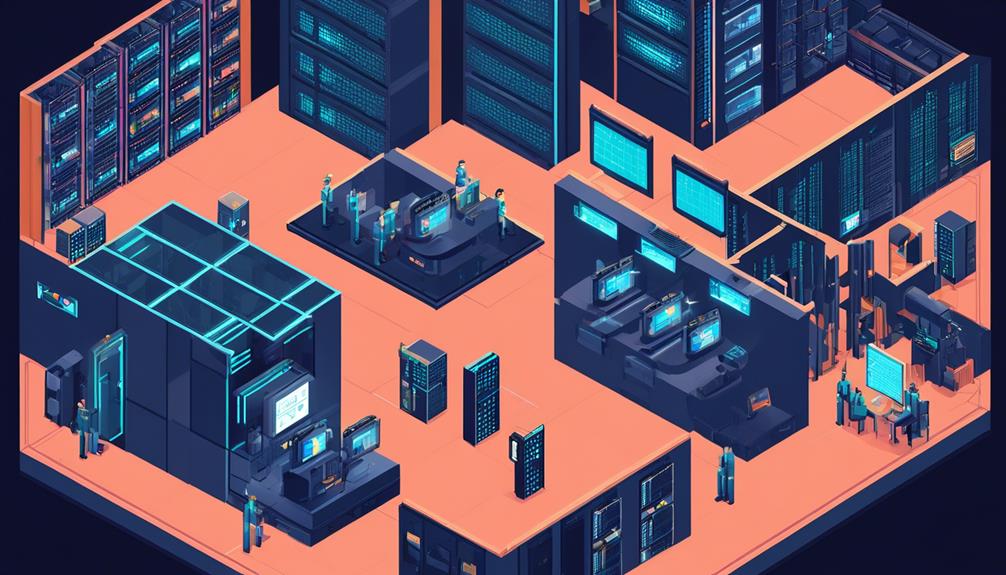As data centers become increasingly critical to the functioning of businesses and organizations, the need for robust security measures has become paramount. Traditional security systems may not be equipped to handle the complex and evolving nature of cyber threats. This is where AI-based data center security systems come into play.
By harnessing the power of artificial intelligence and machine learning, these systems have the ability to revolutionize data center security. They offer advanced threat detection capabilities, intelligent access control, automated security tasks, and real-time incident response, among other features.
In this discussion, we will explore the role of AI in data center security and delve into the various applications and benefits of AI-based data center security systems.
Key Takeaways
- AI-based data center security systems leverage advanced algorithms to detect and respond to threats in real-time.
- These systems continuously monitor the data center environment and learn from historical data to identify anomalies and potential risks.
- AI-optimized hardware, such as GPUs and FPGAs, supports the computational demands of machine learning algorithms, enabling faster and more accurate threat detection.
- AI-driven access control systems and enhanced authentication methods, such as facial recognition and biometric authentication, enhance physical security and reduce the risk of unauthorized breaches.
Role of AI in Data Center Security

AI plays a pivotal role in data center security by leveraging advanced algorithms to analyze vast amounts of data and detect potential threats in real-time. With the increasing complexity and volume of data generated in data centers, traditional security systems are often inadequate to effectively identify and respond to emerging threats. This is where AI-powered solutions come into play.
Machine learning algorithms form the foundation of AI-driven data center security systems. These algorithms can continuously monitor the data center environment, analyzing various data sources such as logs, network traffic, and user behavior patterns. By learning from historical data and detecting anomalies, AI algorithms can identify potential security breaches that may go unnoticed by human operators.
One key advantage of AI in data center security is its ability to provide real-time threat detection. Traditional security measures often rely on manual analysis and response, which can be time-consuming and prone to human error. AI, on the other hand, can rapidly analyze vast amounts of data, identify patterns, and detect potential threats in real-time. This enables security teams to respond swiftly and effectively to mitigate risks.
Furthermore, AI-powered predictive analytics enhance data center security by proactively addressing vulnerabilities. By analyzing historical data and identifying patterns, AI algorithms can predict potential security weaknesses and recommend measures to address them. This allows organizations to prioritize security efforts and allocate resources effectively.
In addition to threat detection and predictive analytics, AI can also automate routine security tasks, reducing human error and response time in security incidents. By automating tasks such as log analysis, system monitoring, and incident response, AI frees up security personnel to focus on more strategic and complex security challenges.
Moreover, AI can enhance access control and video surveillance in data centers. By integrating AI algorithms with access control systems and video surveillance cameras, data centers can improve physical security measures. AI can analyze video feeds in real-time, identify suspicious behavior or unauthorized access attempts, and trigger alerts for immediate action.
AI-Optimized Hardware for Data Center Security
AI-optimized hardware plays a pivotal role in enhancing the efficiency and security of data center operations. It efficiently supports complex machine learning algorithms and is crucial in the context of data center security systems. AI algorithms are used to analyze vast amounts of data and identify potential threats or anomalies. However, executing these AI algorithms requires significant computational power and resources. This is where AI-optimized hardware comes into play.
Hardware accelerators, such as graphics processing units (GPUs) and field-programmable gate arrays (FPGAs), enable the execution of AI applications at scale. They facilitate massive data processing and deep learning techniques. These specialized hardware accelerators are designed to handle the computational demands of AI workloads, providing the necessary power and performance to process and analyze large datasets in real-time.
By leveraging AI-optimized hardware, data centers can ensure efficient resource management and support the infrastructure for training and deploying machine learning models. These hardware solutions enable data centers to handle the high computational requirements of AI algorithms, enabling faster and more accurate threat detection and prevention.
Moreover, AI-optimized hardware also contributes to the security of data center operations. It provides robust encryption and decryption capabilities, ensuring that sensitive data is securely stored and transmitted within the data center environment.
AI-based Threat Detection in Data Centers

With the utilization of advanced hardware accelerators and machine learning algorithms, data centers are able to leverage AI technology for efficient and real-time threat detection. AI-based threat detection systems analyze vast amounts of data to identify potential security threats in data centers. By using machine learning algorithms, these systems can detect patterns and anomalies in network traffic, allowing for immediate response to potential threats. AI has the capability to continuously learn and adapt to new and evolving security threats, reducing the burden on human security analysts and ensuring proactive security measures.
To provide a clearer understanding of the benefits of AI-based threat detection in data centers, the following table highlights key features and advantages:
| Features | Advantages |
|---|---|
| Predictive analytics | Enables risk assessment and proactive vulnerability mitigation |
| Real-time threat detection | Allows for immediate response and mitigation of security threats |
| Continuous learning | Adapts to new and emerging threats, ensuring up-to-date protection |
| Enhanced physical security | AI-powered access control and video surveillance improve data center security measures |
AI-powered data center management and security systems are crucial in protecting sensitive information and ensuring the smooth operation of data centers. By employing AI technology, organizations can effectively detect and respond to security threats in real-time, reducing the risk of data breaches and ensuring the integrity of their systems. With predictive analytics and continuous learning capabilities, AI-based threat detection systems provide proactive security measures, addressing vulnerabilities before they can be exploited. Additionally, the integration of AI-powered access control and video surveillance enhances physical security measures, further safeguarding data centers from unauthorized access.
Machine Learning for Data Center Security
Machine learning plays a pivotal role in enhancing data center security by analyzing vast amounts of data to identify potential threats. Here are four ways in which machine learning is utilized to strengthen data center security:
- Real-time threat detection: AI algorithms can detect patterns and anomalies in network traffic, enabling real-time threat detection and immediate response. By continuously analyzing network data, machine learning algorithms can identify suspicious activities, such as unauthorized access attempts or abnormal data transfers, and alert security teams to take necessary actions promptly.
- Predictive analytics: Machine learning algorithms can analyze historical data to predict potential security risks and proactively address vulnerabilities in data centers. By learning from past incidents and patterns, AI can identify potential weaknesses and suggest security measures to mitigate future threats. This predictive capability allows data center operators to stay one step ahead of potential attacks.
- Intelligent access control: AI can provide intelligent access control to prevent unauthorized access to data center facilities. Machine learning algorithms can analyze user behavior, authentication logs, and other contextual data to identify suspicious access attempts. By continuously learning from these patterns, AI can dynamically adjust access control policies and provide an additional layer of security.
- Enhanced video surveillance: Machine learning algorithms can analyze video feeds from surveillance cameras to detect unusual activities or suspicious behavior within the data center premises. By leveraging computer vision and deep learning techniques, AI can identify potential security breaches and alert security personnel in real-time, enabling swift response and mitigation.
AI-driven Access Control Systems

AI-driven access control systems offer enhanced authentication methods, such as facial recognition and biometric authentication, to bolster data center security.
These advanced algorithms enable real-time threat detection, allowing for immediate identification and prevention of unauthorized access attempts.
Additionally, these systems provide intelligent access monitoring, ensuring continuous surveillance and reducing the risk of insider threats and unauthorized breaches.
Enhanced Authentication Methods
Enhanced authentication methods, powered by artificial intelligence, revolutionize access control systems in data centers, ensuring utmost security measures. These advanced authentication techniques leverage AI algorithms to provide intelligent access control and prevent unauthorized entry.
Here are four key features of AI-based enhanced authentication methods for data center security:
- Facial recognition: AI-driven access control systems use facial recognition technology to accurately identify individuals, allowing only authorized personnel to enter the data center.
- Biometric authentication: By incorporating biometric data such as fingerprints or iris scans, AI-based systems provide an additional layer of security, making it virtually impossible for unauthorized individuals to gain access.
- Insider threat detection: AI algorithms within access control systems can detect anomalous behavior and prevent insider threats by flagging suspicious activities, reducing the risk of data breaches.
- Integration with threat detection: Enhanced authentication methods can be seamlessly integrated with AI-driven threat detection systems, creating a comprehensive security solution that effectively safeguards data centers against various security risks.
With AI-based enhanced authentication methods, data centers can achieve robust security measures, protecting valuable data from unauthorized access and potential breaches.
Real-Time Threat Detection
Building upon the advanced authentication methods discussed earlier, data centers can further enhance their security measures with real-time threat detection systems powered by artificial intelligence. These systems leverage AI and machine learning algorithms to analyze network traffic and identify potential security threats as they occur. By detecting patterns and anomalies in network activity and access logs, real-time threat detection enables immediate response and mitigation of potential security breaches within data centers. The AI-driven nature of these systems allows them to continuously learn and adapt to new and evolving cyber threats, enhancing their effectiveness over time. Moreover, automated real-time threat detection reduces the burden on human security analysts and enables faster response to potential security incidents. The following table illustrates the key features and benefits of AI-driven real-time threat detection systems:
| Features | Benefits |
|---|---|
| Analyzes network traffic | Identifies potential security threats in real-time |
| Uses machine learning | Detects patterns and anomalies in network activity |
| Enables immediate response | Mitigates potential security breaches promptly |
Intelligent Access Monitoring
Intelligent Access Monitoring systems, powered by AI, revolutionize access control in data centers by employing advanced authentication techniques and biometric recognition to ensure heightened security. These AI-driven access control systems have the capability to detect and prevent unauthorized access attempts, reducing the risk of insider threats.
Here are four key benefits of intelligent access monitoring:
- Enhanced Security: By utilizing facial recognition and biometric authentication, these systems provide a higher level of security compared to traditional access control methods.
- Improved Threat Identification: Integration with AI-powered threat detection systems allows for real-time identification of potential security threats, further enhancing the overall security posture of data centers.
- Prevention of Data Theft: Intelligent access monitoring plays a crucial role in preventing unauthorized access to sensitive information, reducing the risk of data theft and ensuring data integrity.
- Increased Control: These AI-based solutions provide data center administrators with granular control over access permissions, allowing them to easily manage and monitor access rights for different individuals and groups.
Automation of Security Processes With AI

Automation of security processes with AI revolutionizes data center security by streamlining routine tasks, enhancing threat detection, and providing proactive vulnerability management.
AI systems are capable of automating routine security tasks, such as log analysis, which greatly improves operational efficiency. By offloading these mundane tasks to AI, human security analysts can focus on more critical and complex issues.
Automated threat detection using AI is another significant benefit for data center security. AI-powered algorithms can analyze vast amounts of data in real-time, reducing the burden on human analysts and enabling faster response to potential threats. This advanced technology can detect patterns, anomalies, and suspicious activities that may go unnoticed by human operators, thus ensuring a higher level of overall security.
Furthermore, AI-powered predictive analytics plays a crucial role in proactively addressing vulnerabilities. By leveraging historical data and machine learning algorithms, AI systems can identify potential weaknesses and prioritize areas that require immediate attention. This proactive approach allows data centers to mitigate risks before they can be exploited, reducing the likelihood of security breaches.
In terms of physical security, AI can provide intelligent access control to data centers. Facial recognition and biometric authentication can be integrated into AI systems, ensuring only authorized individuals can gain access. This advanced access monitoring greatly enhances overall security and reduces the risk of unauthorized entry.
Moreover, AI-powered video surveillance adds an extra layer of protection by monitoring data center premises. These systems can detect suspicious activities and potential security breaches in real-time, enabling immediate response and minimizing potential damage.
AI-powered Intrusion Prevention Systems
AI-powered Intrusion Prevention Systems revolutionize data center security by utilizing machine learning algorithms to detect and prevent potential security threats in real-time, enhancing overall protection and reducing reliance on human security analysts.
These systems offer several key benefits:
- Continuous Learning and Adaptation: AI-powered Intrusion Prevention Systems can continuously learn and adapt to new and evolving security threats. By analyzing vast amounts of data and identifying patterns, these systems can quickly identify and respond to potential threats, minimizing the risk of successful attacks.
- Intelligent Access Control: AI can provide intelligent access control to data centers, utilizing facial recognition and biometric authentication to enhance security. This ensures that only authorized individuals can access sensitive areas, reducing the potential for insider threats.
- Video Surveillance and Threat Detection: AI-powered video surveillance can monitor data center premises, detecting suspicious activities and sending alerts for potential security breaches. Advanced algorithms can analyze video feeds in real-time, identifying anomalies and potential threats, allowing for proactive security measures.
- Automation of Routine Security Tasks: The automation of routine security tasks, such as log analysis, by AI-powered systems reduces human error and improves efficiency in data center security operations. By offloading these tasks to AI, security analysts can focus on more complex and strategic security measures.
Data Analytics and AI in Data Center Security

Data analytics and AI play a crucial role in data center security by enabling AI-enabled threat detection, real-time anomaly detection, and predictive maintenance analysis.
With AI's ability to analyze vast amounts of data, it can identify potential security threats in data centers and proactively address vulnerabilities through predictive analytics.
Additionally, AI-powered data analytics can provide real-time monitoring and detection of anomalies, ensuring prompt response to any suspicious activities.
This combination of data analytics and AI empowers data center security systems to enhance overall security and mitigate potential risks.
Ai-Enabled Threat Detection
With the advancement of artificial intelligence, data analytics and AI are revolutionizing threat detection in data center security.
AI-enabled systems have the capability to analyze vast amounts of data, allowing for the identification of potential security threats.
Machine learning algorithms can detect patterns and anomalies in network traffic, enabling real-time threat detection and immediate response and mitigation.
Additionally, AI systems can continuously learn and adapt to new and evolving security threats, enhancing the overall effectiveness of threat detection in data center security systems.
By automating the process of threat detection, AI reduces the burden on human security analysts, allowing them to focus on more complex and critical tasks.
This integration of AI in data center security systems provides a more efficient and proactive approach to threat detection and mitigation.
Real-Time Anomaly Detection
Real-time anomaly detection in data center security leverages the power of artificial intelligence (AI) and data analytics to swiftly identify unusual patterns in network traffic, access logs, and system behavior.
This advanced technology utilizes AI models and deep learning algorithms to continuously learn and adapt to new and evolving security threats.
By analyzing vast amounts of data in real-time, real-time anomaly detection enables security teams to detect and respond to potential security threats promptly.
This automated approach reduces the burden on human security analysts and improves the efficiency of data center security operations.
Real-time anomaly detection plays a crucial role in preventing unauthorized access, data theft, and potential cyber attacks in data center environments.
Its ability to detect anomalies in real-time allows for swift response and mitigation, enhancing the overall security posture of the data center.
Predictive Maintenance Analysis
Predictive maintenance analysis in data center security harnesses the power of AI and data analytics to proactively identify and address potential hardware issues, minimizing downtime and optimizing the overall security of the facility.
Here are four key aspects of predictive maintenance analysis in data center security:
- AI and Data Analytics: Predictive maintenance analysis utilizes AI algorithms and data analytics to analyze historical data and identify patterns that indicate potential hardware issues or vulnerabilities.
- Targeted Security Measures: By leveraging predictive maintenance analysis, data center operators can identify high-risk areas and prioritize vulnerabilities based on their potential impact. This allows for targeted security measures to be implemented, reducing the risk of security breaches.
- Improved Incident Response: Predictive maintenance analysis enables data center operators to proactively address hardware issues before they escalate into critical incidents. This improves incident response time and minimizes the impact of any potential security breaches.
- Continuous Learning: Machine learning models used in predictive maintenance analysis continuously learn and adapt to new and evolving security threats. This ensures that data center security systems remain up-to-date and effective in defending against emerging risks.
AI-enhanced Video Surveillance for Data Centers

AI-enhanced video surveillance is a crucial component in ensuring the comprehensive security of data center facilities. With the increasing importance of data centers in today's digital landscape, protecting these facilities from unauthorized access and potential security breaches is of utmost importance.
Traditional video surveillance systems have limitations in terms of their ability to monitor and analyze large amounts of video feeds in real-time. This is where artificial intelligence (AI) comes into play.
By integrating AI algorithms into video surveillance systems, data centers can benefit from real-time monitoring and analysis of their premises. AI-powered video surveillance systems utilize advanced technologies such as facial recognition to identify and track individuals attempting unauthorized access to the facility. These systems can also analyze video feeds to detect potential security breaches, such as unusual behavior or suspicious activities.
The integration of AI-powered video surveillance with threat detection systems allows for a more proactive defense strategy, enabling data center operators to respond quickly to potential threats.
Intelligent video surveillance not only enhances the overall physical security of data center facilities but also provides valuable insights for operational efficiency. For example, AI algorithms can analyze video footage to identify patterns and trends in foot traffic, helping data center operators optimize the layout and design of their facilities. Additionally, AI-powered surveillance systems can generate automated reports and alerts, reducing the need for manual monitoring and enabling security personnel to focus on critical tasks.
AI for Real-time Incident Response in Data Centers
AI for real-time incident response in data centers is crucial for ensuring prompt threat detection and mitigation.
By leveraging machine learning algorithms, AI systems can continuously learn and adapt to evolving security threats, enabling proactive incident response.
These AI-powered systems reduce the burden on human analysts and enable quick, automated response to security incidents, enhancing data center security overall.
Real-Time Threat Detection
Real-time incident response in data centers is enhanced by the application of advanced artificial intelligence technology. AI-based data center security systems play a crucial role in real-time threat detection, ensuring the immediate identification and response to security threats as they occur.
Here are four key benefits of using AI for real-time threat detection in data centers:
- Proactive Incident Mitigation: AI-powered machine learning algorithms enable the real-time detection of patterns and anomalies in network traffic. This proactive approach allows for the swift identification and mitigation of potential security incidents before they can cause significant harm.
- Continuous Learning and Adaptation: AI systems continuously learn and adapt from past incidents, enabling them to identify and respond to new and evolving security threats in real time. This adaptive capability ensures that data centers remain protected against emerging threats.
- Automated Threat Detection: By automating the threat detection process, AI reduces the workload on human security analysts. This enables quicker response times, as AI systems can analyze vast amounts of data in real time, identifying and alerting security teams to potential threats.
- Enhanced Data Center Security: Real-time threat detection is crucial for maintaining a secure data center environment. It helps prevent unauthorized access and data theft, ensuring the integrity and confidentiality of sensitive information.
Automated Incident Mitigation
Automated incident mitigation in data centers leverages advanced artificial intelligence technology to provide real-time response to security incidents. By utilizing AI algorithms, data centers can detect and respond to security threats in real-time, minimizing the burden on human analysts. This enables immediate response to security incidents, reducing response time and potential damage. Automated incident mitigation continuously learns and adapts to new and evolving security threats, ensuring the system remains effective over time.
To further illustrate the benefits of automated incident mitigation, consider the following table:
| Benefits of Automated Incident Mitigation in Data Centers |
|---|
| 1. Real-time threat detection and response |
| 2. Reduced burden on human analysts |
| 3. Continuous learning and adaptation to evolving threats |
These benefits highlight how AI-based data center security systems with automated incident mitigation enhance the overall security posture of data centers, providing efficient and effective incident response capabilities.
Enhanced Data Center Security
Building upon the capabilities of automated incident mitigation, enhanced data center security leverages advanced AI technology to provide real-time incident response and threat detection in data centers. This approach utilizes AI analytics to analyze vast amounts of data and identify potential security threats and vulnerabilities.
Here are four key aspects of enhanced data center security:
- Threat detection: AI-powered systems can continuously monitor data center operations and identify any suspicious activities or anomalies in real-time. This enables proactive threat detection and prompt response to potential security breaches.
- Predictive analytics: By leveraging AI algorithms, data centers can proactively assess and analyze patterns to identify potential security risks and vulnerabilities. This allows for preemptive measures to be taken to strengthen the security infrastructure.
- Access control: AI enables enhanced access control systems that use advanced authentication methods, such as biometrics and facial recognition, to prevent unauthorized access to data center facilities. This ensures that only authorized personnel can enter the premises.
- Intelligent surveillance: AI-based video surveillance systems can intelligently monitor data center premises, identifying any unauthorized access or suspicious activities. This enhances physical security and enables immediate response to potential threats.
Through the integration of AI technology, enhanced data center security optimizes incident response, strengthens physical security, and mitigates potential risks, providing a robust security framework for data centers.
Future of AI in Data Center Security
The future of AI in data center security holds immense potential for enhancing proactive threat detection and response capabilities. AI-based data center security systems can revolutionize the way organizations protect their critical infrastructure from cyber threats. By leveraging AI algorithms, these systems can analyze vast amounts of data to identify potential security threats in real-time.
One of the key advantages of AI-based data center security systems is their ability to perform predictive analytics. By continuously monitoring and analyzing data, AI can help organizations proactively address vulnerabilities and prioritize high-risk areas for targeted security measures. This not only enhances the overall security posture but also enables efficient resource allocation.
AI can also provide intelligent access control and facial recognition capabilities, further enhancing security in data centers. By using advanced algorithms, AI can verify the identity of individuals accessing the facility and detect any unauthorized access attempts. This can significantly reduce the risk of physical breaches and insider threats.
Additionally, AI-powered video surveillance can play a crucial role in data center security. By continuously monitoring video feeds, AI can detect suspicious activities and send real-time alerts for potential security breaches. This allows security teams to respond promptly and take necessary actions to mitigate risks.
Furthermore, AI can automate routine security tasks, such as log analysis, which reduces the burden on human security analysts. AI algorithms can quickly scan code and identify potential vulnerabilities, minimizing the risk of false positives and allowing analysts to focus on more critical security issues.
Frequently Asked Questions
What Is AI Based Security System?
An AI-based security system is a cutting-edge technology that utilizes machine learning algorithms to detect patterns and anomalies in network traffic. It enables real-time threat detection and immediate response, enhancing overall security measures. By proactively identifying potential risks and prioritizing vulnerabilities, it improves incident response and reduces downtime.
AI-powered systems also provide intelligent access control through facial recognition and biometric authentication, preventing unauthorized access attempts and reducing insider threats. Additionally, AI-powered video surveillance enhances physical security by monitoring premises in real-time.
How Can AI Be Used in Data Security?
AI can be used in data security to enhance threat detection, access control, video surveillance, and automate routine security tasks. It can analyze vast amounts of data to identify potential threats, provide intelligent access control, monitor premises in real-time, and automate log analysis.
However, there are ethical implications, challenges, and limitations associated with AI-based security systems.
Future applications include enhanced proactive defense strategies through the collection and analysis of threat intelligence.
Ultimately, AI-based data security systems offer numerous benefits for businesses, improving efficiency and enhancing overall security measures.
How Is AI Used in Data Centers?
AI is extensively used in data centers for various applications. Its applications in data center management include intelligent access control, video surveillance, and automation of routine security tasks.
The benefits of using AI in data centers include enhanced security through the analysis of vast amounts of data, detection of patterns and anomalies in network traffic, and real-time monitoring of premises.
However, implementing AI in data center security also poses challenges such as data privacy and integration issues.
Looking ahead, future trends in AI for data center security include advanced threat detection and predictive analytics.
What Is an Example of AI in Security Surveillance?
AI-powered facial recognition, AI-driven anomaly detection, AI-enabled predictive analytics, and AI-assisted threat intelligence are all examples of AI in security surveillance. These technologies enhance overall physical security by providing real-time analysis and detection of potential threats.
AI-powered facial recognition can detect unauthorized individuals and send alerts for potential security breaches.
AI-driven anomaly detection identifies abnormal behaviors or activities that may indicate a security threat.
AI-enabled predictive analytics can anticipate and prevent security incidents.
AI-assisted threat intelligence helps security analysts stay ahead of evolving threats.

